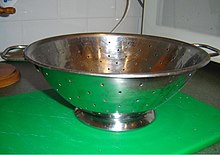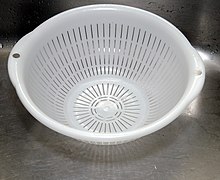Colander


A colander (or cullender) is a bowl-shaped kitchen utensil with holes in it used for draining food[1] such as pasta or rice. A colander is also used to rinse vegetables.
The perforated nature of the colander allows liquid to drain through while retaining the solids inside. It is sometimes also called a pasta strainer or kitchen sieve.
Conventionally, colanders are made of a light metal, such as aluminium or thinly rolled stainless steel. Colanders are also made of plastic, silicone, ceramic, and enamelware.[2]
The word colander comes from the Latin colum meaning sieve.[1]
Other uses

The colander in the form of a pasta strainer was adopted as the religious headgear of the religion (or pseudoreligion) Pastafarianism in deference to the Flying Spaghetti Monster.[3]
See also
References
- ^ a b "Colander (2011)". Merriam-Webster.
- ^ Colander. CooksInfo.com. Published 02/12/2007. Updated 10/15/2010. Web. Retrieved 11/30/2012 from http://www.cooksinfo.com/colander
- ^ "Pastafarian protester carries an icon of the Flying Spaghetti Monster at Piazza XXIV Maggio square in Milan, Italy, on June 2 2012". Wikimedia Commons.
